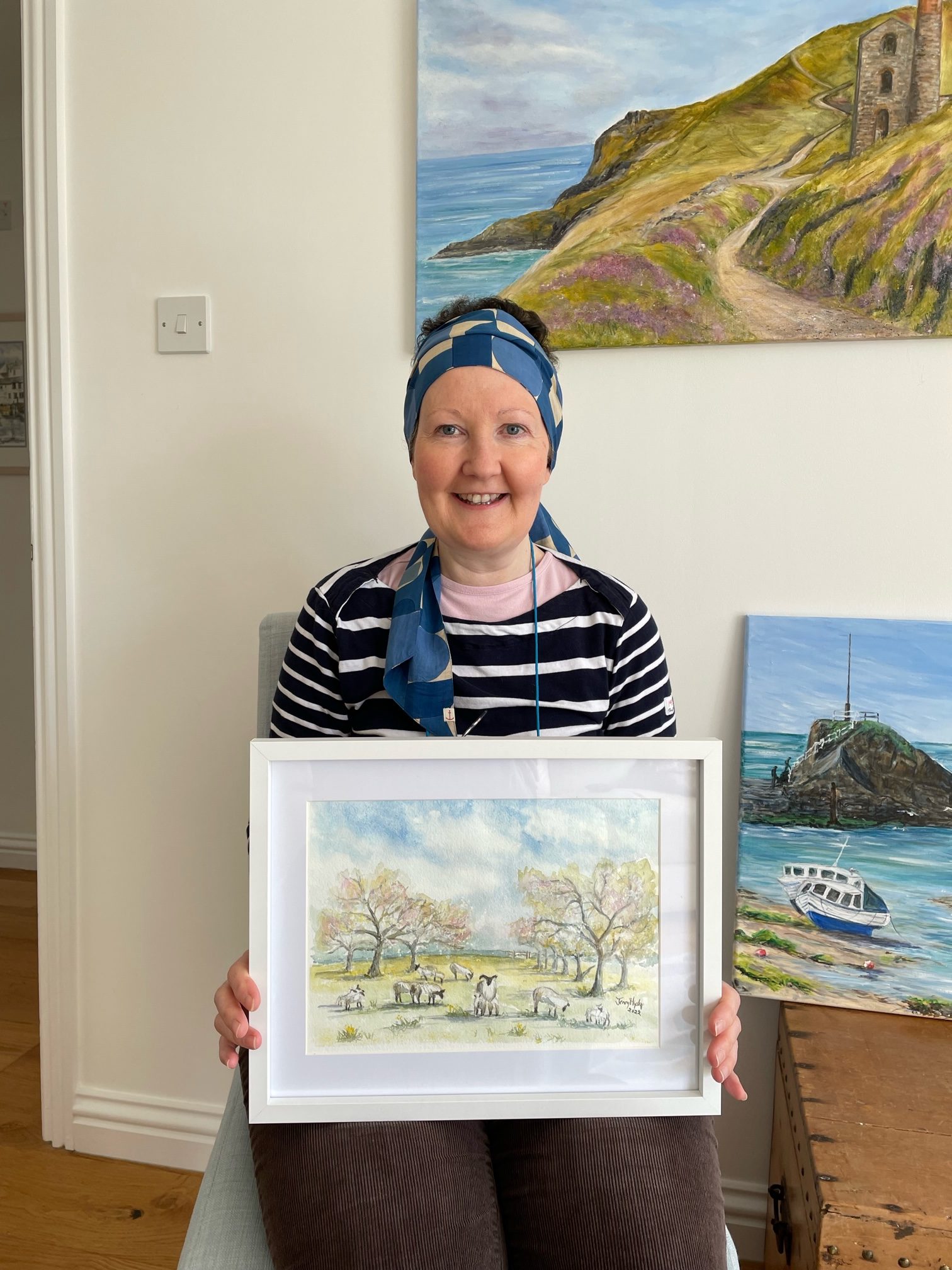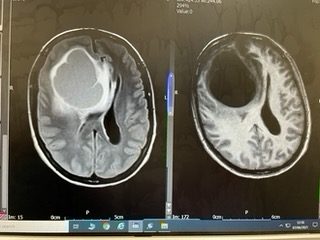How art has helped me on my brain tumour journey, and will continue to do so…
I was diagnosed with Anaplastic Astrocytoma grade 3 a year ago after feeling not well for several months. I was working full time running my own private podiatry practice, and had been a podiatrist for 22 years. I was getting increasingly fatigued and struggling to get through the day. I was trying to cut down my work load but just before I was able to go part-time I seemed to deteriorate and kept having falls due to loss of balance, headaches, dizziness and confusion and forgetfulness. I think as I was just coming up to age 50 at the time they put it down to my age and menopausal symptoms or anxiety. I ended up with my patients concerned about me and one in particular insisted I see the Doctor. My Mum was also worried due to me falling.
podiatrist for 22 years. I was getting increasingly fatigued and struggling to get through the day. I was trying to cut down my work load but just before I was able to go part-time I seemed to deteriorate and kept having falls due to loss of balance, headaches, dizziness and confusion and forgetfulness. I think as I was just coming up to age 50 at the time they put it down to my age and menopausal symptoms or anxiety. I ended up with my patients concerned about me and one in particular insisted I see the Doctor. My Mum was also worried due to me falling.
Luckily a different doctor one day carried out neurological tests and decided I needed to get straight to A and E. My parents took me, and because it was a bank holiday it was packed. We sat there for hours. Because of Covid-19 my parents were advised to leave. I don’t remember much after that, it’s like I lost all memory of what happened. Apparently my husband came to take over from my parents around 11pm but he was asked to stay outside.
Eventually I had an MRI and a cyst was found on my brain, it was causing pressure so they admitted me with a view to operating the following week. However, over the weekend I deteriorated and had to have an emergency craniotomy in the early hours of the May bank holiday. My brilliant neurosurgeon literally saved my life by draining a very large cyst on my brain. This was then followed up with a 2nd craniotomy 3 weeks later to have as much as could safely be removed of the tumour that had been underlying the cyst.
“It was a very hard time for me as I suddenly lost my business, my driving license and my independence. Our whole world and life we knew had gone and it felt extremely difficult.”
It was a very hard time for me as I suddenly lost my business, my driving license and my independence. Our whole world and life we knew had gone, and it felt extremely difficult. But with the help of my family and husband I got back on my feet. I started doing short walks with my parents and husband and literally a few weeks I was doing short walks most days. Last September I took part in a Brain Tumour Research sponsored walk and that was when I had just finished the radiotherapy and was on my 2nd chemotherapy round. I only walked 3 miles, but for me that was a huge achievement and I managed to raise £1,395 which blew me away.
I had always loved painting and drawing but with a busy diary I only really had time to paint when on holiday. One of my friends said why don’t you just do a small doodle of anything about how
you feel. I thought about this and then as the weather was improving being in May I decided to sit outside in my garden and paint some spring flowers. These I realised would make nice cards.
From there I built on making more designs to keep the interest. I managed to find a local printer to produce my cards.
“It was exhausting, but we got through it. I always had a flask of tea and a ginger biscuit as a treat when I got out to the car.”
Once I had recovered from the surgery about a month later I started the six and half weeks of daily radiotherapy at Derriford hospital which is a 70 mile round trip from home, my dad was so good as he took me to most of the appointments. It was exhausting, but we got through it. I always had a flask of tea and a ginger biscuit as a treat when I got out to the car.
 In September 2021 I started chemotherapy TMZ. Although my initial MRIs were stable my latest one unfortunately showed that the tumour in fact was re-growing. They sent me for a very detailed 3 T scan that took one and a half hours, which is a long time to lie very still. When I was asked to see the oncology doctor face-to-face I had a feeling it wouldn’t be great news. Her registrar said they thought it was progression rather than tissue damage. This was a terrible blow as I was feeling, if anything, better than I had and I was feeling I was on the countdown for chemotherapy. The hardest thing was being told to stop having chemo as it wasn’t working and although awful, I felt I’d list some control over trying to fight the tumour.
In September 2021 I started chemotherapy TMZ. Although my initial MRIs were stable my latest one unfortunately showed that the tumour in fact was re-growing. They sent me for a very detailed 3 T scan that took one and a half hours, which is a long time to lie very still. When I was asked to see the oncology doctor face-to-face I had a feeling it wouldn’t be great news. Her registrar said they thought it was progression rather than tissue damage. This was a terrible blow as I was feeling, if anything, better than I had and I was feeling I was on the countdown for chemotherapy. The hardest thing was being told to stop having chemo as it wasn’t working and although awful, I felt I’d list some control over trying to fight the tumour.
Her registrar said they thought it was progression rather than tissue damage. This was a terrible blow as I was feeling, if anything, better than I had and I was feeling I was on the countdown for chemotherapy.
I have now just seen my Consultant neurologist who explained the tumour has regrown with a nodule that needs to be removed by surgery. He hopes to remove all of this and hopefully more of the original remaining tumour. I was so upset once I got home and it had sunk in what had been said. I felt I had lost all that I had worked to over the last year. I had a few days of crying but now beginning to accept that its something I have to deal with and my operation is June 6th. I’m very nervous and really hope that I can move on and perhaps be offered different treatments once I’m
all healed again.
Once again it’s art that I’m able to use to focus on and manage my anxieties and worries, and lately I’ve been able to support a few charities. Since starting all the treatments it has been so nice to have the time to put to my favourite hobby of painting and drawing and I was inspired to make my art work into printed cards to sell in aid of the Brain tumour support charity.
I was invited by Ellen Yates who is a volunteer for the Devon and Cornwall brain tumour support who founded with some other people a crafters group for people who had been affected themselves or a family member with a brain tumour and had a craft, bake or paint, that they would like to produce to be able to sell in aid of the BTS. I had already made cards in aid of a local sea pool at Bude so I thought why not try to sell in aid of brain tumour charity’s as well.
“I find when I’m painting it completely absorbs my mind and its like a meditation as you are in the painting. It stops me worrying and over thinking my future and “ifs and buts”. This in turn prevents or lessens anxiety.”
I find when I’m painting it completely absorbs my mind and its like a meditation as you are in the painting. It stops me worrying and over thinking my future and “ifs and buts”. This in turn prevents or lessens anxiety. It gives me great pleasure to think people like my paintings enough that they would like to purchase them. They then in turn feel they are supporting a good cause at the same time.
I love to paint sea-scapes, as I love the sea and the coast for walking. Also, before I became unwell I used to swim in the Bude sea pool regularly. I also recently started painting wild birds. The good old favourite being the Robin, and I have a puffin that is very popular. My Mum loves chickens and asked me to paint a chicken scene and it was so popular, this was a really boost to my confidence and to help put profits of the cards to fundraising for BTS.
“I love to paint sea-scapes, as I love the sea and the coast for walking.”
My support worker Claire at Derriford encouraged me to undertake the 6 week online hope course last year designed to help people, patients and carers with long term challenges and challenging health issues to learn ways of coping using managing strategies, such as being grateful each day for something even small things, to combat anxiety and to build hope and inspiration into our everyday lives. This I did and found it a great help.
Earlier this year I had some emails from one of the organisers of the hope charity called Gabriella as she was going to organise a Hope punk art exhibition in Coventry to celebrate the Hope course and its success as well as promote its course. She asked me to send my story and photos of my art work and this led to me sending up a selection of my cards for her to use to hand out to the visitors to spread a little hope to take home. I was so chuffed to be part of the show. This was such a success the exhibition was extended a couple of weeks.
“I have chosen to donate a painting of sheep in a spring orchard as I feel it gives the feeling of hope and new beginnings and is a scene that may appeal to a wide audience.”
brainstrust contacted me after I sent them the details of the exhibition and my art work as I take part in the Hypnotherapy sessions with Louise Baker who is fantastic at providing hypnotherapy to brain tumour warriors in their own home via zoom. This time I have donated a watercolour painting to brainstrust to put on their online exhibition auction. This will again hopefully raise much needed funds for the charity. I have chosen to donate a painting of sheep in a spring orchard as I feel it gives the feeling of hope and new beginnings and is a scene that may appeal to a wide audience.
“I would definitely advise anyone in a similar situation to me to aim to do something positive everyday. Even if it is just to walk around the garden and note what’s coming into flower and what birds you can hear.”
I would definitely advise anyone in a similar situation to me to aim to do something positive everyday. Even if it is just to walk around the garden and note what’s coming into flower and what birds you can hear. Hobbies such as crafts are so good at focusing the mind, and if it helps raise funds and puts a smile on someone’s face it does make managing yourself and your personal worries much easier to cope with.
It’s certainly not easy, there are thankfully more good days than bad for me. As you can see from my journey so far, one thing leads to another and as one door shuts another opens. Never give up hope. Everyday we are blessed to be here and it needs to be grasped with both hands and made the best of. I hope I may have inspired some of you to try something new, I believe it helps keep the mind on track.







